Today, I’d like to dispel a common amigurumi myth…
In amigurumi, as with all crochet, you should always be keeping tension on the yarn to keep your stitches compact and regular. But I often hear misinformation that you should be ‘crocheting tightly’ to make amigurumi, and that’s not true at all!
The tightness of amigurumi stitches refers to the tension of the small stiff stitches of the fabric you produce, not to the tension in your hands while you crochet.
Showing is better than telling, so allow me to demonstrate, via a new crochet investigation, how to make perfect amigurumi stitches without hurting your hands!
Experiment 1: Effect of Hook Size
I crocheted the same sample amigurumi cup shape 3 times with different sized hooks and the same worsted weight yarn each time. I crocheted the same way as I would when making a scarf or anything else – I kept my tension even, but didn’t try to pull my stitches tightly or pull back on the yarn after pulling up each loop.
I used my standard amigurumi E hook (3.5mm), and, to show the effects of changing hook sizes, I tried a larger H hook (5mm) and a smaller C hook (2.75mm).
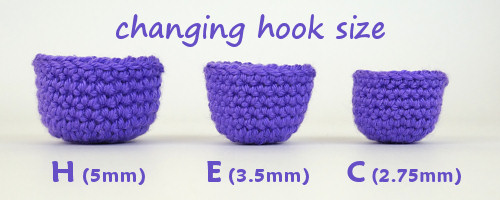
You can see that the stitches are neat and even in all three samples and, as you may expect, using a larger hook results in a larger finished piece that’s both taller and wider than the same piece crocheted with a smaller hook.
See how the smaller hook samples can stack inside the larger ones? There’s quite a size difference!
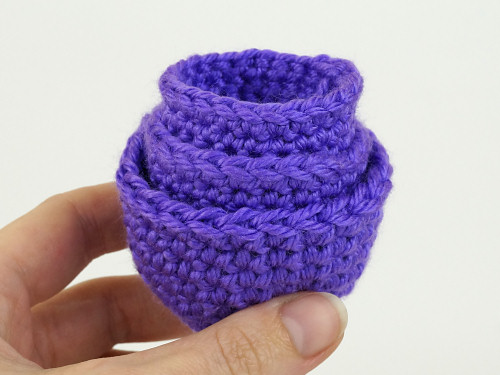
What you can’t tell from a photo is how stiff the fabric of each sample is. With the H hook, the fabric is too floppy to hold its shape well. With the E hook, the fabric is much firmer and holds its shape much better. With the C hook, the piece is even firmer and feels very solid.
I simulated the effect of adding stuffing by gently stretching out each piece between my fingers, so you can see the gaps between the stitches:

As you can see, the H hook fabric is far too open for an amigurumi; the gaps between the stitches are very noticeable. With the E hook, the stitches have smaller holes between them, so the stuffing would be far less visible. And, with the C hook, the gaps between stitches are almost invisible.
So here’s the result of changing hook size: a smaller hook gives a smaller and firmer crocheted piece, with tighter stitches and smaller gaps between the stitches.
These are the properties we want for amigurumi fabric! A stiff, sturdy fabric that holds its shape and has tiny gaps between the stitches is exactly what we need for crocheting a 3-dimensional sculpture.
The C hook was the smallest hook I could manage with this specific yarn (Caron Simply Soft, a light worsted weight yarn), and I had to stop and undo a stitch a few times, when my hook hadn’t grabbed all the plies of the yarn. I wouldn’t recommend using a hook quite this small, as it’s annoying to have to undo your work whenever you realise you have a snag in your stitches from splitting the yarn with the small hook.
My Recommendation: In practice, with a light worsted weight yarn like this, I might go down to a D hook for the best balance of small, tight stitches and not splitting the yarn as I crochet. For the heavier worsted weight yarns, I still recommend an E hook for most amigurumi.
(See my Worsted Weight Yarn Comparison for more about the differences between different yarns that are all labelled as worsted weight!)
Experiment 2: Effect of ‘Crocheting Tightly’
Now, part two of this investigation. I returned to my standard E hook and tried crocheting the same sample piece yet again, but this time I followed the misunderstood advice of ‘crocheting tightly’. I held the yarn tightly and pulled back on it against my hook each time I formed a loop, so each loop was tight around the hook and as small as possible.

Both these samples were crocheted with the same hook. As you can see, the ‘tight’ piece is smaller and firmer than the normally-tensioned piece, but at what cost?
When you crochet with too-tight tension, your stitches are so small that it’s hard to work back into them, and that’s what happened in this case: it was an effort to force my hook into each stitch. My yarn-holding hand began to cramp from pulling the yarn so tightly, and I didn’t enjoy the process of crocheting at all. Even finishing this small piece was very hard work.
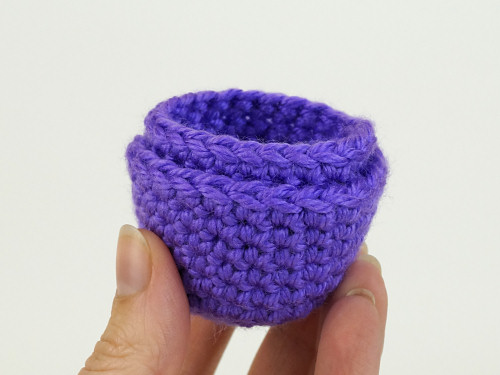
Yes, the tight piece is definitely smaller (and therefore ‘better’ for amigurumi) but crocheting it was a horrible experience!
In amigurumi, chains and slip stitches should not be crocheted with your usual tension. These stitches need to be crocheted with an extra-relaxed tension (or a larger hook), or they’ll be too small to work back into.
See my tutorial Chains and Slip Stitches in Amigurumi for more on this.
Experiment 3: Comparing Smaller Hook and Tighter Tension
Now, let’s compare the small (C hook) sample from Experiment 1 with the extra tight tension sample (E hook) from Experiment 2:
Can this be right? They look almost identical!
Yes, comparing the two pieces, they look and feel almost exactly the same – the size and shape are the same, the stiffness of the fabric is the same, the gaps between stitches are the same.
The only difference? The sample on the left was crocheted comfortably with a small hook, and the sample on the right was crocheted extra-tightly, at great discomfort, with a larger hook.
Conclusions
As these experiments have shown, there’s absolutely no advantage to changing the way you crochet when you make amigurumi by working extra-tightly (and you may actually hurt your hands, wrists and arms by doing so!)
The goal with amigurumi is to maintain tension (down and backwards) on the yarn that’s balanced by your hook pulling up and forwards. This control allows you to form neat, consistent stitches.
You should never feel you have to force your hook into every stitch and/or pull your stitches as tightly as possible. This not only distorts your fabric but can also lead to hand and wrist fatigue and repetitive stress disorders.
The secret to making good-looking amigurumi without making your hands hurt is simple:
- Select an appropriately small hook and crochet the same way as you usually do.
- The perfect hook for your yarn is the smallest size you can manage without starting to have problems from splitting your yarn because the hook is too small to consistently grab all the plies.
The result: neat tight stitches, with no pain!
If you ever experience discomfort when making amigurumi, I encourage you to relax that death grip on your hook and yarn, and try crocheting with a slightly smaller hook instead. Your hands will love the difference and, I hope, you’ll enjoy the amigurumi-making process more.
Have you fallen for the amigurumi myth of ‘crocheting tightly’? Please leave a message in the comments and share your experiences…
Loved this tutorial? I have so many more amigurumi tips and tricks to share with you!
Boost your amigurumi skills with my latest book, The Essential Guide to Amigurumi, your comprehensive guide to amigurumi techniques and tips.
Do you find my tutorials helpful? If so, please consider making a contribution towards my time so I can continue to create clear and concise tutorials for you:
Thank you so much for your support! Now click below for loads more crochet video and photo tutorials (and do let me know what else you’d like me to cover in future tutorials…)

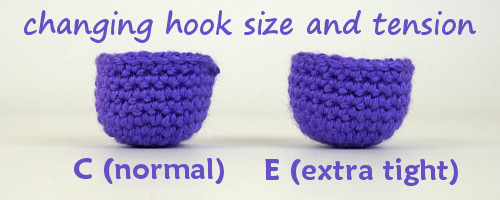
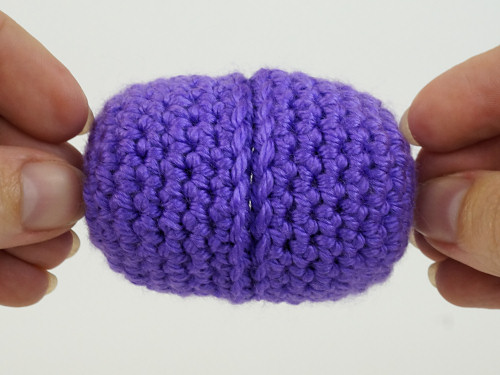
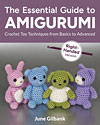
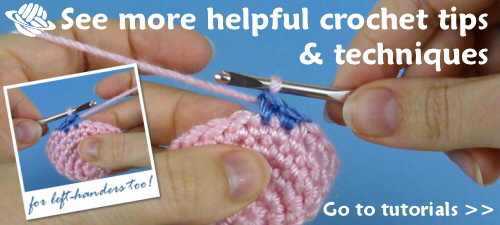















Joelle said
Wow thank you! Game changer advice!
I am a beginner with amigurumi and have been holding the yarn tension so tightly that I get two indents in my finger from wrapping the yarn around it and the occasional electrical shock up my left arm.
I am going to try going down a half size on my hook instead.
I almost gave up amigurumi altogether but gosh they are so fun and cute.
Ren said
This is exactly the kind of information I was looking for when I did an online search on this topic! Thank so much for creating this resource! It was very, very helpful 🙂
Geena said
Absolutely excellent post!! Thank you so much for all of the info and great images!!
Ella said
Some times when I use a smaller hook size for tighter tension the piece is bigger than it was with the larger hook and tight tension. Do you know why this happens?
June said
It depends on a few factors: how much smaller your small hook is, how loosely you crochet with the small hook, and how tightly you pull your yarn when you’re using your tight tension! If you crochet loosely with the small hook, you’ll end up with larger stitches.
If you want to relax your tension but your small hook isn’t giving you small enough stitches, you can either try an even smaller hook (provided it’s still larger enough to catch all the plies of your yarn as you work, you can go as small as you want), or try crocheting slightly more tightly with your small hook (but not as tightly as you do with the big hook!)
Evelyn said
I am so impressed with your videos, tutorials, and the pattern that I bought. You really have a gift at teaching and explaining. I would love to buy your books also, but I refuse to buy anything aimed at dummies or idiots. I am neither of those. I am a novice. lol
Do you have any books with more gentle titles? ♥
June said
Unfortunately I can’t do anything about the series title that my books are a part of – that’s down to the publisher – but I do agree that they’d be much better named as “from scratch” or “for beginners” instead of insulting their potential readers. I certainly don’t think that any of my readers are idiots!
I’m unlikely to write more crochet books, as I’ve written the two I wanted to write (a reference book on crochet in general and one specifically about amigurumi) – I don’t know what else people would want me to teach in book form! I hope you can look past the titles to the high quality reference books I wrote – it’d be a shame to miss out just because of the series name…
If you’d like to read more about them before you make your final decision, I’ve written about them here:
Kristina said
Such a great and thorough explanation for hook size and tension for amigurumi! I have always loved the conciseness of your tutorials.
Barbra said
Thank you so much for this! I took up crochet a few months ago and loved the idea of doing amigurumi but started hating it almost immediately because of my tension issues. It was painful and took forever because I could barely get the hook through my stitches. I thought I was using a small enough hook but after reading this I switched to a smaller one and now my stitches look great, I’m not killing myself to get the hook through, and I’m enjoying it!
Laura said
Thank you so much for this article! I am a beginner and have been crocheting my amigurumi way too tight, thinking that it was how it needed to be done, and I wasn’t enjoying the process at all. I am going to redo the project I’m working on and relax, to see the difference in the finished pieces.
Anna baldacchino said
i like to use smaller hook to do becouse its come meet and the stitchs comes smaller thanks
Deanna said
This is so amazing!! I have struggled with finding the secret to amigurumi and I believe you just nailed it. Thank you so much for this very informative post.
Anlet said
Gostaria de saber como comprar os padr
June said
Hi Anlet, all PlanetJune patterns are available in English language only (see my FAQ for more information on this).
Tina said
Thank you, June. I had volunteered to make zebras for children with pulmonary hypertension. After making the first one I had almost decided to un-volenteer. My hands cramped and it took me a long time to make the first because was reluctant to go through that pain again. Your information has made me rethink it and I
Miranda said
Thank you June for all your beginners tutorials. I am a beginner in some areas of Crocheting myself and I always struggle with smaller pieces and tension.
Christine Bakker said
Hi June
I luvvvvv your stuff and explanations.
please send new comments.
thank you
Christine
Ant said
Thank you for a carefully explained piece on tension. I know I am doing something wrong as my tension gets tighter and tighter with each new project (currently cats – they are getting smaller and smaller) but I seem unable to correct it. I guess I will just have to practice until it changes.
Nicola Parfitt said
Thank you so much for this tutorial. It is really useful to know what I was doing wrong on a recent project. I was doing really well until I got to the decreases and suddenly I could not get my hook through the stitches which I had obviously tightened up too much and I ended up being so frustrated and hot and bothered with it I gave up and as you say the process was no longer enjoyable. I undid a few rounds following this tutorial and lightened my grip only to find it now worked much better.
P.S Really love your patterns!
Deborah said
Thanks June! Ironically, I took up amigurumi as I thought I had found the place where my “death grip crochet” style was appropriate. I produced super tight and firm pieces but my right wrist ached. It hurts to crochet now. Will slack off a bit with the small hook as those foxes are calling to me!
Thanks!
Deborah
Nancy Eidson said
I had lost my joy in crocheting due to the “death grip” as you so aptly called it. Until your post I thought I would just have to stop and no longer have that joy. I just never knew what I was doing wrong and the pain caused was unbearable. Thank you for your insight, you cured my trouble! Looking forward to many more years of fun ahead!
Blessings,
Nancy
June said
I’m so glad to hear this was helpful to you, Nancy! I hope you’ll be able to enjoy crocheting again now 🙂
Judy Carlson said
Thanks for another great scientific exploration of crochet techniques. I think you are unique in producing these!
June said
My training as a scientist always shows through 😉
Susan said
Oh June! Thank You So Much for this incredibly helpful tutorial! I have been crocheting Amigurumi using the
June said
I’m so pleased to hear this was helpful to you, Susan! If my tutorials help even one person, it’s all worthwhile 🙂
Kate said
Yes! When I first learned to crochet I thought I had to pull the yarn tightly. It was so difficult to get the hook into the stitches. Also, the extreme tension made for an uneven finished product! Learning to relax and use the correct hook made a world of difference! (Reading your books when I started out also helped tremendously!) ?